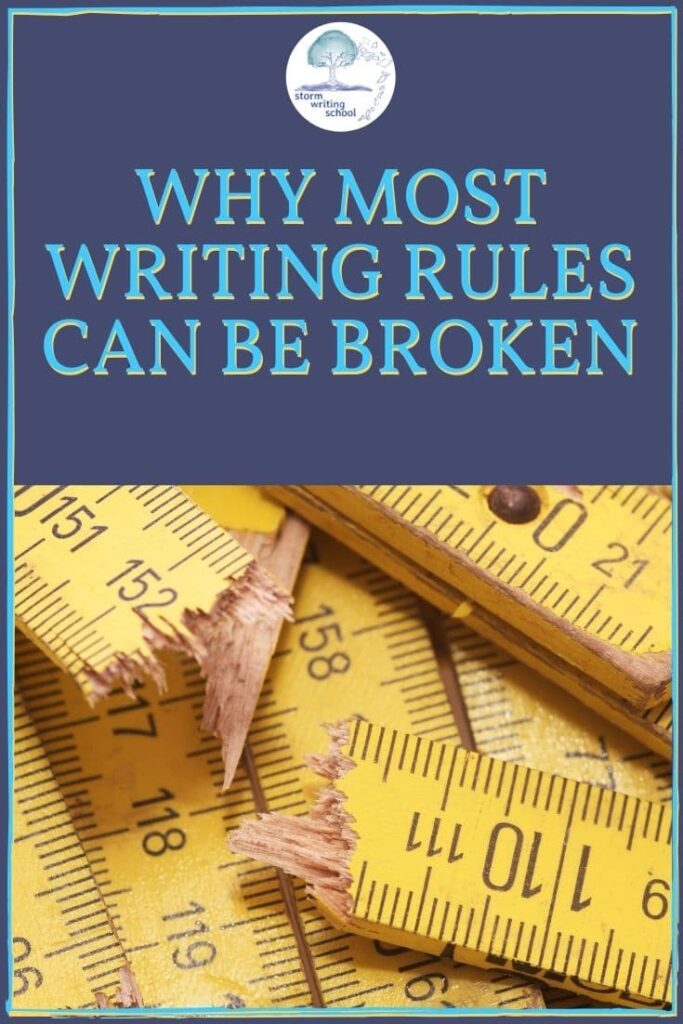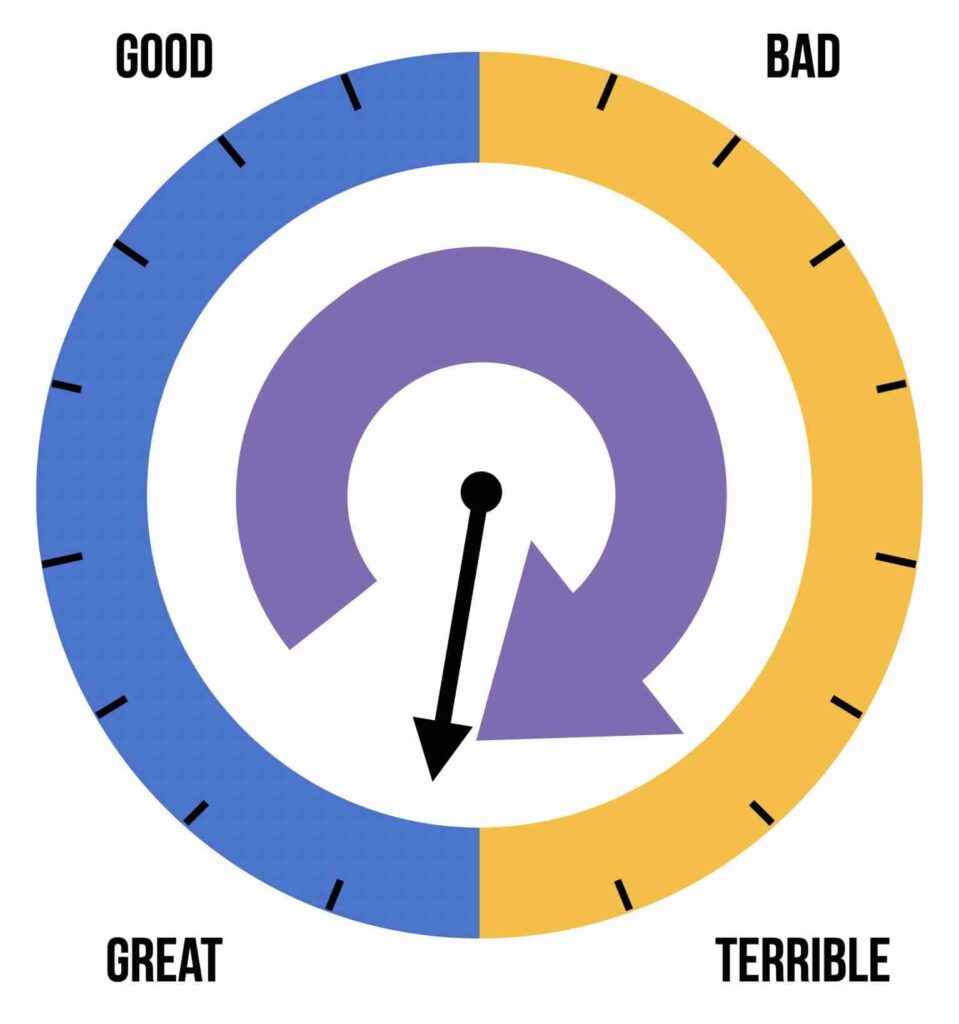Almost every writing rule you can think of has exceptions. Why? And if breaking writing rules is possible, why pay any attention to them?

The Case of the Effective Deus Ex Machina
Earlier this year, I read a book called Fifteen Dogs. The premise is a strange one: Hermes and Apollo are hanging out in a bar debating whether animals would live happily if they had human intelligence and consciousness. So they decide to go to a dog shelter and give the dogs there (15 of them) human consciousness and see what happens.
The story then follows these dogs as they deal with their new awareness of existence. It’s a pretty captivating read, and a couple of times, the main character dogs—the ones we’re really rooting for—get out of trouble purely because of interference from the gods watching over them.
It is classic deus ex machina. And in most other books, I would cry foul. But in this story, it works because the whole premise is rooted in random godly interference.
The Case of the POV Smorgasbord
In the same month I read Fifteen Dogs, I also read a middle-grade novel, The Inquisitor’s Tale by Adam Gidwitz. It’s a frame narrative in the style of The Canterbury Tales. Sundry folk are brought together in an inn, and they each take turns telling the story of three saintly children and their adventures across the French countryside.
It’s an absolute hodgepodge of narrative POVs. Sometimes it’s first person, sometimes it’s third. Sometimes it’s past tense, sometimes it’s present. Sometimes it’s third limited, sometimes it’s omniscient. Sometimes it’s even first person omniscient somehow.
But in this story, it works. Again, it’s because the whole story is sort of predicated on the importance of books and storytelling in coming to understand, well, God, really. (But you could also substitute God for “what’s right.”)
Subvert the Maxims
For pretty much every “rule” you’ve heard for writing, there is some story out there that illustrates an exception.
Don’t name too many characters in chapter 1; show, don’t tell; escalate toward a climax; prioritize scenes over narrative summary; avoid coincidence. There are stories—good stories—that subvert each of these. And for pretty much any maxim you can think of, there is likely a story out there that successfully bypasses it.
That’s not to say that those maxims aren’t good advice. “Show, don’t tell,” for instance, is a principle that every writer should attempt to master. But it can also get you in trouble, and there are times when telling is actually preferable to showing. It’s a good idea to know how to avoid filter words in your narration, but there are times when they, too, are not only acceptable, but actually better than the alternative.
But Why?
Why isn’t writing something we can pin down a little better? Why can’t we come up with a list of rules that apply universally? Why can’t it be more of a science?
There are a few meta-principles at play here—that is, principles about why writing principles can be undermined.
Metrics
Some writing instructors have tried to make writing a science, providing spreadsheets and graphs and various recipes and formulas. And I’ll admit that such formulas can be helpful for generating story ideas and direction.
But when assessing written work, the world does not agree on a single metric. And even those of us who use formulas to one degree or another rarely measure others’ work by their adherence to formula.
Science is of little utility when the metric is not agreed upon.
You ask how fast my car can go, and I say 50. Is that fast? It depends a lot on whether we’re talking kilometers per hour or miles per hour or meters per second or parsecs.1 For readers, the units of measure vary a lot.
Some readers are looking for a page turner.
Some readers are probing for meaning.
Some readers are looking for an immersive setting.
Some readers are interested in fascinating characters.
Some readers are looking for music in the language.
That is what I mean by different metrics.
And allow me to elaborate by switching metaphors here. Think of a radio with a dial. What you’re trying to do as a writer is dial in to a radio station and eliminate the static. That can often take some fine tuning (that is, multiple rounds of revision). But then once listeners have dialed in, they may still be disappointed. They’ve found a well-written, static-free story, but it just wasn’t the kind of music they were looking for.
It’s important to note, though, that I’m not just talking about genre here. It isn’t that the listeners were hoping for rock and they got jazz. It’s that they got rock, but it had something they didn’t like—some dissonance or falsetto singing or a complicated time signature. Their metric for a quality rock song was different from the metric used by the musician or another listener.
So we arrive at meta-principle #1: Because the metrics vary so much, there is no fool-proof, scientific prescription for efficacy.
Accumulation
As with music, written art (and, indeed, all art) is in conversation with the work that has come before it. Art alludes, calls back, lampoons, adapts, recasts, reimagines, recycles. Let’s say we come across a comedic love story about, I don’t know, dogs. We understand immediately if it is responding to and playing with some ideas that have been articulated or enacted previously, like perhaps Romeo and Juliet:
But soft, what yonder light comes floating through the darkened park? Tis one of those glowing tennis balls that Jesse’s human got her for her birthday, whatever that is.
Comedic writing is perhaps especially poised to flout almost any writing rule you can throw at it. Take, for instance, this narrative, tweeted by Sandra Newman, which is full of cliches and tired tropes:
A horse walks into a bar. It is a weasel bar. A rough bar in a hard-knock, weasel part of a weasel town. On every stool at the bar is a weasel, and every weasel has a face like trouble.
The bartender says, “Why the long face?” The weasels all laugh but their eyes aren’t smiling.
“Cut the jokes,” says the horse. “Tell me what you know about a duck called Jack ‘Quack’ Lafferty.”
“Duck?” the bartender says, polishing the bar with a rag. “I don’t know about no duck.”
“You heard him,” says a weasel at the bar. “He don’t know no duck. This is a weasel joint.”
The horse grabs the offending weasel by the collar and slams its face into the bar.
“Whoa!” says the bartender. “Leave the kid be! Sure, I know Quack Lafferty. I heard he was spending time at that mouse place.”
Newman and her husband Howard Mittelmark wrote a book called How Not to Write a Novel, and it’s full of ridiculous scenarios like this one, intentionally written to be bad. The thing is, they’re often so funny and fun that they kind of flip right back over into good.

Comedy is just the approach with the easiest and clearest access to self-aware breaking of the “rules,” but almost any narrative approach can incorporate comedy, and even those that are earnest and serious can riff on a cliche or toy with a trope (Interior Chinatown does this constantly).
Thus, meta-principle #2: Because art accumulates, because it responds to previous works, it can often “break” the rules to create new meanings from the conversation it is taking part in.
Subversion
And this brings us to another reason that stories can break the rules. It’s a reason that is perhaps less obvious than the above reasons, but it’s built into what storytelling is by its very nature.
A story lays out expectations. Or maybe it’s that a reader can’t help but interact with a story with expectation.
If we begin a story, “Once upon a time, there was a boy who was afraid of water,” we expect that we’ll soon see that boy face some form of water in the narrative.2
If we see that boy come to a river he needs to cross in order to escape another form of danger, we start to make predictions about how and whether he’ll make it across.
If in crossing the raging river in a boat, the boy falls into the water, we form expectations about his survival strategies and his fate.
It’s not that readers make one guess and stick with it. They usually come up with a few theories.
When the boy is at the river’s edge with some villain coming his way, as he looks around for options, we might surmise that he’ll find a bridge or a boat or that he’ll take measure of the water’s depth and decide to wade through.
The writer thinks through all these options, too. But the writer knows that the simplest and most obvious solution is the one to avoid. It’s a sort of reverse Occam’s Razor. Or as George Saunders says, “No worthy problem is ever solved in the plane of its original conception.”3
Story by its very nature is engaged in a perpetual shell game with the reader; story tries to evade the reader’s guesses about what will happen next.
And so we arrive at meta-principle #3: Because stories by their nature try to subvert reader expectations, they sometimes break the rules we expect of them.
What to Do with the Rules?
Okay, so rules can be broken. But then why should we pay attention to any of them if that’s the case?
Well, here’s the thing: they’re not rules.
They’re principles rooted in theories about how stories affect people.
Think music theory, which is comprised of principles about how various notes and rhythms can be combined to create the desired effects on most listeners.
Study music theory, and you can learn about scales and intervals and chords. You can learn about how various combinations of notes can create harmony or dissonance. You can learn about how a song’s rhythm can interact with the time signature it’s in.
And you can then learn about how most listeners will perceive that a 7th note in a scale “wants” to lead back to the tonic. Or that a minor scale tends to feel dark or melancholy. Or that syncopation makes listeners want to move.
Music theory and story theory—they’re not necessarily trying to be prescriptive and tell you what to do. I know that writing theory is often phrased as a prescription, as advice, but perhaps it shouldn’t be. Perhaps it should phrased as “here’s something you can do, and here’s the common effect is has on readers” or “here’s something that often has an effect of boring readers or disorienting them or repulsing them, so take caution as you write or revise.”
Learn the rules/principles/theories and then make decisions about how to use, combine, disregard, subvert, or otherwise bend those techniques for your purposes.
1Yeah, science nerds, I know parsecs is actually a distance rather than a measure of speed, even if various Star Wars stories get it wrong repeatedly.
2This is from George Saunders in A Swim in Pond in the Rain.
3As Saunders explains, this is actually a misquote of Einstein that Saunders heard from a student of his; later, after learning of the original quote, he preferred the misquoted version.





One Response